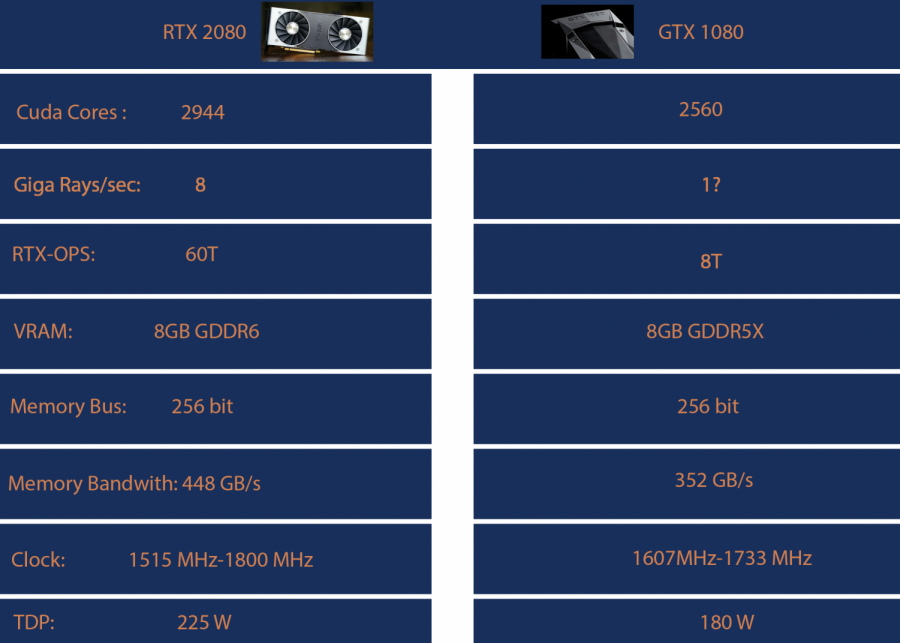Nvidia Corporation released four new graphics cards towards the end of the year. Currently, these cards are the top-of-the-line GPUs that Nvidia has to offer. The company has been encouraging these next generation cards by giving buyers two games, Anthem and Battlefield V, incentives to buy the cards. However, these GPUs are not the only graphics cards on the market, and it is important for students to consider what the cards do for them and why they are important.
I will provide some definitions of terms to make the explanations more comprehensible for beginners. To find other definitions that may be helpful read the CPU article.
Definitions:
RAM, or Random Access Memory (also called “memory” for simplicity) is used by a CPU to store temporary data before it is processed. There are two different kinds of RAM, DDR SDRAM (Double Data Rate Synchronous Dynamic RAM) which helps the CPU function, and GDDR SDRAM (Graphics Double Data Rate Synchronous Dynamic RAM) which helps the GPU function.
Ray Tracing is an algorithm used by animators to color and create their images. The new RTX 2080 allows for real time ray tracing, but this new component comes with a price hike.
AI-based graphical enhancement is a technology used by the new RTX graphics cards. More specifically, this tech helps content creators improve the quality of their work by using AI to artificially enhance certain parts of an image.
CUDA cores are similar to processors in CPUs, but the main difference is that there are thousands of CUDA cores in a single graphics card. Many CUDA cores allow games and programs to run at very high settings. However, this is not the only thing CUDA cores are used for; researchers and software developers are able to send C or C++ code directly to the GPU without obstacles.
VRAM, also known as video ram, is the amount of RAM that the graphics card has. Keep in mind that not all GPU have VRAM. For desktops, the VRAM is typically stored in the GPU.
Giga Rays are related to the ray tracing and its effectiveness in relation to the Cuda cores.
The Memory Bus connects to the system memory, CPU, and the L2 cache. It allows for the transfer of data between different components of a motherboard.
Memory Bandwidth is the speed of the VRAM. Faster memory bandwidth means a faster graphics card.
Base clock or core clock is related to the speed at which the GPU functions, and sometimes this speed can be boosted. When the clock is boosted, it is known as a boost clock. Higher core clock’s numbers generally indicate an increase of performance and better looking images.
Finally, the TDP or thermal design power is the maximum amount of power that the GPU will consume.
The RTX-OPS has to do with how the new cards function and are a new method of measuring their power regarding the Turings’ Ray Tracing. Turings’ Ray Tracing is a different method of ray tracing that is being used in the newer GPUs. Higher values for the RTX-OPS result in better GPUs.
What is a graphics card?
A graphics card, or GPU, is a piece of hardware that works to display programs on the computer screen. It renders video and images, and the GPU is typically added onto a motherboard through a dedicated slot. The GPU helps with 2D data but preforms best when it comes to decoding or rendering images or videos, which is why students in the arts would want a decent GPU to assist them in their artistic endeavors.
Sometimes the GPU is incorporated into the CPU, which then becomes what is known as an integrated CPU. The main difference between GPU and CPU combos is that when the GPU is part of the CPU they share the same Random Access Memory while a separate GPU has its own RAM.
These graphics cards are essential to people such as animators and other content creators.
So, to provide some information to the general public I plan on giving a rundown comparing both the RTX 2080 and the GTX 1080. Keep in mind that the RTX 2080 and the GTX 1080 are not the only graphics cards available, I only bring these up because they are the ones I am familiar with. There are other cards such as the AMD Radeon, but I cannot directly compare them because they are made differently.
The main appeal of the GTX 2080 is that it has DLSS, which allows it to boost frame rates and prevent a fall in performance due to ray tracing. The power this card has will pair well with high refresh rate monitors.
Quick Note, also known as Deep Learning Super-Sampling(DLSS), creates a lower resolution image and then improves the image using deep learning algorithm.
The general specs of the card are as follows: The CUDA Cores are 2944 for the RTX 2080 and 2560 for the GTX 1080. To be honest, the RTX 2080 is incredible compared to some of its predecessors like the GTX 970 which has 1664 CUDA cores. For a student, the GTX 970 is a perfect fit for all-around use. If you plan to pick a graphics card, the GTX 970 would be a cost-effective choice.
The RTX 2080 has eight Giga Rays/sec and quite possibly one Giga Rays/sec for the GTX 1080 (the manufacturer does not give specifics for the GTX 1080). The RTX 2080 is a step up from the GTX 1080 because it provides better support to the ray tracing. Why is it important to have ray tracing? Well, it seems that many of these newer GPU emphasize its use to create better quality images. As a result, there have been changes as to how GPUs work. Before, Giga Rays/secs were not a unit of measurement; they only existed in ray tracing GPUs.
I am now going to talk about the RTX-OPS scores of 60T for the 2080 and the 8T for the 1080. Compared to the RTX 2080, the GTX 1080 is dwarfed by the power of the 2080 in this specific category. The 1080 stands no chance compared to the RTX 2080s Turings’ ray tracing ability. No surprise here, because as I mentioned earlier, ray tracing is something GPU manufacturers stress when making powerful GPUs.
The VRAM is 8GB GDDR6 for the 2080 and 8GB GDDR5X for the 1080. While these values may seem the same, there is a slight difference. The GDDR6 is a new kind of VRAM, and as a result, there is not much information as to how it is different from its previous versions GDDR5X and GDDR5.
The Memory Bus is 256-bit for the RTX 2080 and 256-bit GTX 1080, so ultimately, there is no difference; the only change here is the hardware.
The Memory Bandwidth is 448 GB/second for the RTX 2080 and 352 GB/second for the GTX 108. It is obvious that the Memory Bandwidth will be better with the RTX 2080. However, like I mentioned earlier, the GTX 970 works well with 224 GB/s. I cannot stress enough that when picking these cards, do not go for flashiness or style; choose what works best for what you do.
The Base clock is 1515 MHz and 1800 MHz for the RTX 2080, and 1607 MHz and 1733 MHz for the GTX 1080. Oddly enough, the base clock of the RTX is a bit slower, but perhaps: this choice is up to the user to make. As you can tell, these cards can be “overclocked,” which means they can be pushed past their factory defaults to become faster. So these lower settings could be for user preference.
TDP is 225W for the RTX 2080 and 180W for the GTX 1080, meaning that both these cards will suck a laptop dry of its battery if unplugged and will leave you with a high power bill.
The article is supposed to be about picking a GPU, right? Well, to be honest, you do not need the RTX 2080 or the GTX 1080, and here is why.
These two cards are behemoths and contain a lot of raw power that no one needs. These cards are only made for certain kinds of professions: content creators and animators. These specialized professions require top-of-the-line equipment, and they are the only ones that are cost effective. The RTX 2080 costs more than $1,000, which is why I stress not to pick this card for use. If you love to play video games, do not purchase it! It is a waste of your disposable income because most games only need at most a 1070 graphics card, and there is no need to waste your money.
Aside from the ridicule of how much the RTX 2080 costs, realistically, if you play games, you do not need more than a 1070. The GTX 1070 delivers great performance at $450, and with that extra $550, you could buy a i7 CPU and a motherboard. If you are a student, the GTX 970 will meet your daily needs. Sure, it is a step down from the RTX 2080, but you can still get a lot of work done with it. The GTX 970 can play games and do more productive tasks; you will still receive the best of both worlds without breaking the bank.
Overall, the new cards are ridiculously overpriced, so remember the consequences of buying them: wasting money when you could have received a similar performance with the GTX 1080.





![All members of the Webb Robotics Winter season teams taking a group photo. Of note is Team 359, pictured in the middle row. “It was super exciting to get the win and have the chance to go to regionals [robotics competition]” Max Lan (‘25) said. From left to right: Max Lan (‘25), Jerry Hu (‘26), David Lui (‘25), Jake Hui (’25), Boyang Li (‘25), bottom Jonathan Li (’25), Tyler Liu (‘25)](https://webbcanyonchronicle.com/wp-content/uploads/2025/03/Screenshot-2025-03-10-at-2.41.38 PM.png)




Jayme Silvestri | Feb 7, 2022 at 3:24 AM
Good web site you have here.. It’s hard to find high quality writing like yours nowadays. I really appreciate people like you! Take care!!
Jayme Silvestri
Ramona Mills | Oct 23, 2019 at 3:10 AM
Hello. remarkable job. I did not expect this. This is a splendid story. Thanks!
Ramona Mills